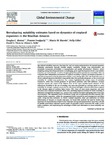Use este identificador para citar ou linkar para este item:
http://www.alice.cnptia.embrapa.br/alice/handle/doc/1064681Registro completo de metadados
| Campo DC | Valor | Idioma |
|---|---|---|
| dc.contributor.author | MORTON, D. C. | pt_BR |
| dc.contributor.author | NOOJIPADY, P. | pt_BR |
| dc.contributor.author | MACEDO, M. M. | pt_BR |
| dc.contributor.author | GIBBS, H. | pt_BR |
| dc.contributor.author | VICTORIA, D. de C. | pt_BR |
| dc.contributor.author | BOLFE, E. L. | pt_BR |
| dc.date.accessioned | 2017-02-17T11:11:11Z | pt_BR |
| dc.date.available | 2017-02-17T11:11:11Z | pt_BR |
| dc.date.created | 2017-02-17 | pt_BR |
| dc.date.issued | 2016 | pt_BR |
| dc.identifier.citation | Global Environmental Change, v. 37, p. 92 - 101, 2016. | pt_BR |
| dc.identifier.uri | http://www.alice.cnptia.embrapa.br/alice/handle/doc/1064681 | pt_BR |
| dc.description | Agricultural suitability maps are a key input for land use zoning and projections of cropland expansion. Suitability assessments typically consider edaphic conditions, climate, crop characteristics, and sometimes incorporate accessibility to transportation and market infrastructure. However, correct weighting among these disparate factors is challenging, given rapid development of new crop varieties, irrigation, and road networks, as well as changing global demand for agricultural commodities. Here, we compared three independent assessments of cropland suitability to spatial and temporal dynamics of agricultural expansion in the Brazilian state of Mato Grosso during 2001?2012. We found that areas of recent cropland expansion identified using satellite data were generally designated as low to moderate suitability for rainfed crop production. Our analysis highlighted the abrupt nature of suitability boundaries, rather than smooth gradients of agricultural potential, with little additional cropland expansion beyond the extent of the flattest areas (0?2% slope). Satellite-based estimates of the interannual variability in the use of existing crop areas also provided an alternate means to assess suitability. On average, cropland areas in the Cerrado biome had higher utilization (84%) than croplands in the Amazon region of northern Mato Grosso (74%). Areas of more recent expansion had lower utilization than croplands established before 2002, providing empirical evidence for lower suitability or alternative management strategies (e.g., pasture?soya rotations) for lands undergoing more recent land use transitions. This unplanted reserve constitutes a large area of potentially available cropland (PAC) without further expansion, within the management limits imposed for pest management and fallow cycles. Using two key constraints on future cropland expansion, slope and restrictions on further deforestation of Amazon or Cerrado vegetation, we found little available flat land for further legal expansion of crop production in Mato Grosso. Dynamics of cropland expansion from more than a decade of satellite observations indicated narrow ranges of suitability criteria, restricting PAC under current policy conditions, and emphasizing the advantages of field-scale information to assess suitability and utilization. | pt_BR |
| dc.language.iso | eng | eng |
| dc.rights | openAccess | eng |
| dc.subject | Amazon | pt_BR |
| dc.subject | Soya | pt_BR |
| dc.title | Reevaluating suitability estimates based on dynamics of cropland expansion in the Brazilian Amazon | pt_BR |
| dc.type | Artigo de periódico | pt_BR |
| dc.date.updated | 2017-07-13T11:11:11Z | pt_BR |
| dc.subject.nalthesaurus | zoning | pt_BR |
| riaa.ainfo.id | 1064681 | pt_BR |
| riaa.ainfo.lastupdate | 2017-07-13 | pt_BR |
| dc.identifier.doi | http://dx.doi.org/10.1016/j.gloenvcha.2016.02.001 | pt_BR |
| dc.contributor.institution | Douglas C. Morton, NASA Goddard Space Flight Center; Praveen Noojipady, NASA Goddard Space Flight Center; Marcia M. Macedo, Woods Hole Research Center; Holly Gibbs, University of Wisconsin; DANIEL DE CASTRO VICTORIA, CNPM; EDSON LUIS BOLFE, SIM. | pt_BR |
| Aparece nas coleções: | Artigo em periódico indexado (CNPM)  | |
Arquivos associados a este item:
| Arquivo | Descrição | Tamanho | Formato | |
|---|---|---|---|---|
| 4802.pdf | 3,3 MB | Adobe PDF |  Visualizar/Abrir |









